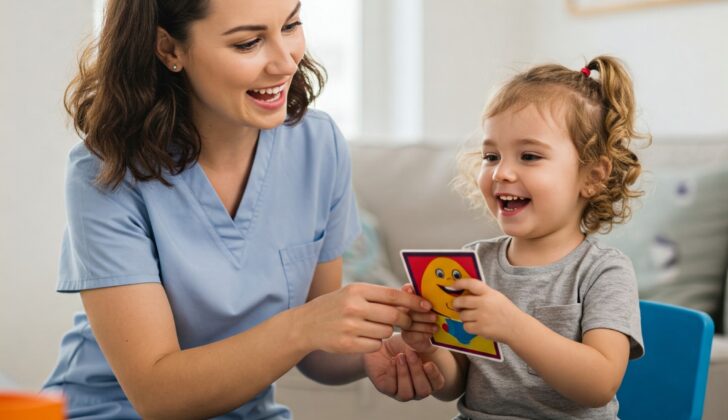Hi there, parents and caregivers!
If your child says “appy” instead of “happy,” you’re in the right place. This guide will help you teach the soft, whispery “H” sound in a fun, easy way—using everyday routines and playtime. No flashcards required!
Why Play Beats Practice
Children learn best through play. It’s how their brains grow, connect, and make sense of the world. Practicing the “H” sound doesn’t need to be a chore—it can happen during breakfast, dress-up, or silly games. You already have everything you need to help your child thrive.
What is the “H” Sound?
The “H” sound is like a gentle puff of air—no buzzing, no tricky tongue moves.
-
No Voice: Your voice box is off—just like a whisper.
-
Just Air: The air flows softly from your throat.
-
Simple Setup: Your tongue and lips stay relaxed. It’s all about the air.
This sound is usually one of the first kids learn—and one of the easiest for them to say.
When Do Children Learn the “H” Sound?
Here’s a quick guide to what’s typical:
| Stage | Age | What You Might Hear |
|---|---|---|
| First Try | ~1 year | “Ha-ha” giggles or breathy sounds |
| Getting the Hang of It | 2–3 years | Saying “hi” or “hat” sometimes—but not always |
| Using It Correctly | By 3 years | “H” sounds used clearly and consistently |
If your child is over 3 and still struggling, it might be time to check in with a pediatrician or a speech-language pathologist. They’ll help rule out things like hearing difficulties or airflow issues.
How to Help Your Child Hear, See & Feel the “H” Sound
Because the “H” sound is all air, it can be tricky for little ones to figure out. Here’s how to make it more noticeable:
See the Sound
-
Magic Mirror: Make “H” sounds in front of a mirror together. “Look! My mouth is open, but nothing’s moving!”
-
Foggy Window Fun: Blow on a mirror or window to make fog. Say “haaa” and draw in the mist!
-
Feather Blower Game: Blow cotton balls or feathers across the table with quick “H” puffs: “h…h…h…”
Feel the Sound
-
Warm Wind Game: Have your child hold their hand in front of your mouth as you say “ha, he, ho.” Let them feel the warm air—then try it themselves.
-
Voice On or Off?: Let your child feel your throat. Say “ahhh” (vibration!) and then “h” (no buzz). It’s a great way to show the difference between voiced and voiceless sounds.
Hear the Sound
-
Sound Hunt Game: Say pairs like “hat/at” or “hot/ot.” Can they tell which one has the “H”?
-
Laugh Out Loud: Take turns making funny laughs: “hee-hee-hee,” “ho-ho-ho,” “ha-ha-ha!”
Everyday Moments to Practice the “H” Sound
You don’t need a speech lesson—just everyday talk and a little creativity.
Morning Routine
-
“Here’s your hat for your head!”
-
“I’m so hungry—how about some honey toast?”
Playtime
-
“Let’s play hide-and-seek! I’ll count. Ready or not, here I come!”
-
“Hello, horse! Let’s hop home to the farm.”
On the Go
-
“Hold my hand while we walk.”
-
“Wow, look at that huge house! Hello!”
Helping at Home
-
“You’re such a big helper. Can you hand me the book?”
-
“Thank you for helping me. High-five!”
A Week of “H” Sound Play
5–10 minutes a day is all you need!
| Day | Activity |
|---|---|
| Monday | Magic Mirror: Make silly faces and whispery “H” sounds |
| Tuesday | Story Time: Read books with “H” words (like Happy Hippo) |
| Wednesday | Hide-and-Seek: Say “Here I come!” and “Hiding!” lots |
| Thursday | Cotton Ball Race: Blow cotton balls with “H” puffs |
| Friday | Laughing Game: Giggle with “hee-hee,” “ho-ho,” and “ha-ha” |
| Saturday | I Spy Walk: “I spy something on your head… hair!” |
| Sunday | Helping Hand: Practice “H” words while making snacks |
“H” Words to Use in Play
Start-of-word favorites
-
People & Actions: he, her, help, here, hide, hit, hold, hug, hurry
-
Objects: hair, hand, hat, heart, hill, home, house, hotdog
-
Feelings: happy, heavy, hot, huge, hungry
-
Greetings: hi, hello
Middle-of-word (less common): ahead, beehive, uphill, grasshopper, doghouse
No words end with “H.” In English, the “H” sound is like a soft breeze—it starts a word but never finishes one.
Final Tips for Your Speech Journey
-
Be Patient: Every child learns in their own time.
-
Make it Playful: Fun creates the best learning!
-
Celebrate Tries: Praise effort more than perfection.
-
Model Gently: If they say “I see an ‘orse,’” just reply, “Yes! I see a big horse too.” No correction needed—just a gentle model.
You Are the Best Teacher
You don’t need a degree in speech therapy to help your child. Your playful spirit, encouragement, and everyday conversations are powerful tools.
With these simple ideas, you’re turning everyday moments into speech-building fun—one happy “H” at a time.
Keep Learning & Stay Connected
Follow First Words Bright Futures on Facebook and Instagram for:
-
Daily speech tips
-
Fun activity ideas
-
Q&A with a pediatric SLP
Watch a Video Example of the Video example of /h/ sound
Explore More:
- MDS: Bouncing into the /B/ Sound: Fun Home Strategies for Boosting Your Child’s Speech
- MDS: Hiss Happens: A Parent’s Guide to Helping Your Child Master the /s/ Sound
Disclaimer: This article offers general educational information. It is not a substitute for professional evaluation or treatment. Please consult a licensed Speech-Language Pathologist for personalized concerns regarding your child’s speech development.











